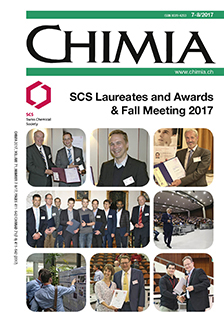Lead Halide Perovskite Nanocrystals: From Discovery to Self-assembly and Applications
DOI:
https://doi.org/10.2533/chimia.2017.461Keywords:
Colloids, Light-emitting devices, Metal halides, Nanocrystals, Perovskites, Photoluminescence, Television displaysAbstract
Lead halide perovskites (LHPs) of the general formula APbX3 (A=Cs+, CH3NH3+, or CH(NH2)2+; X=Cl, Br, or I) have recently emerged as a unique class of low-cost, versatile semiconductors of high optoelectronic quality. These materials offer exceptionally facile solution-based engineerability in the form of bulk single crystals, thin films, or supported and unsupported nanostructures. The lattermost form, especially as colloidal nanocrystals (NCs), holds great promise as a versatile photonic source, operated via bright photoluminescence (PL) in displays or lighting (energy down-conversion of blue light into green and red), or via electroluminescence in light-emitting diodes. In this article we discuss the recent history of the development of highly-luminescent NCs of LHPs, the current state-of-the-art of this class of materials, and the future prospects of this highly active research field. We also report the demonstration of long-range ordered, self-organized superlattice structures obtained from cube-shaped colloidal CsPbBr3NCs using drying-mediated self-assembly.Downloads
Published
2017-08-09
Issue
Section
Scientific Articles
License
Copyright (c) 2017 Swiss Chemical Society

This work is licensed under a Creative Commons Attribution-NonCommercial 4.0 International License.
How to Cite
[1]
Chimia 2017, 71, 461, DOI: 10.2533/chimia.2017.461.







